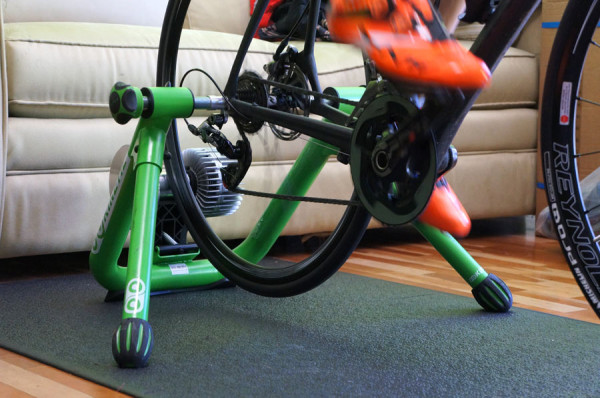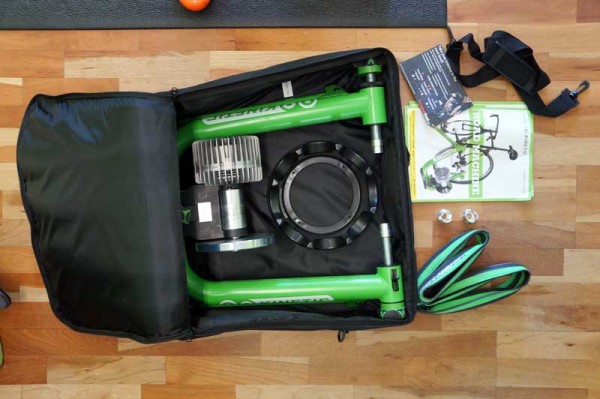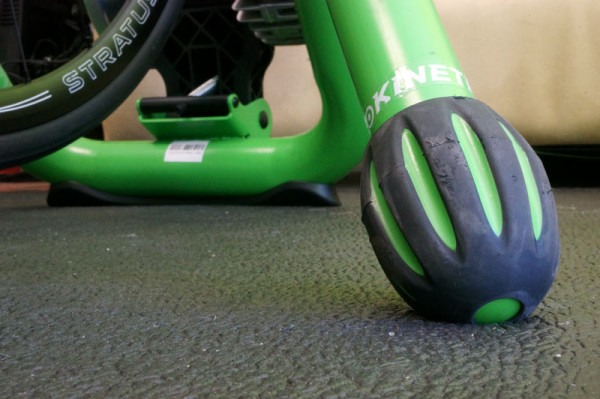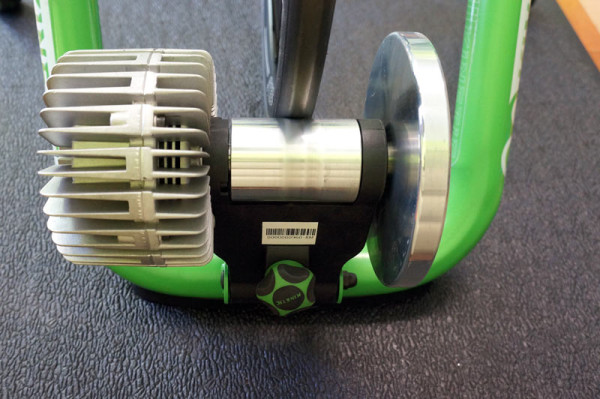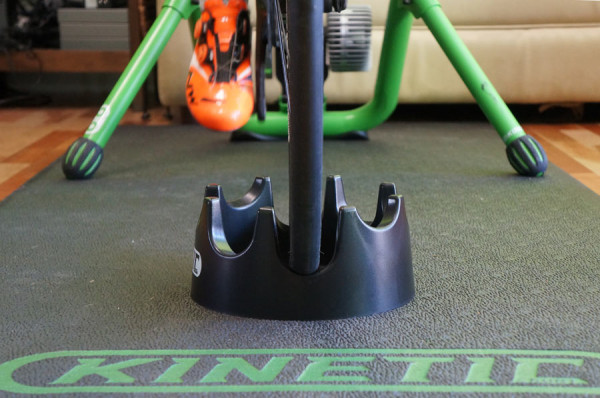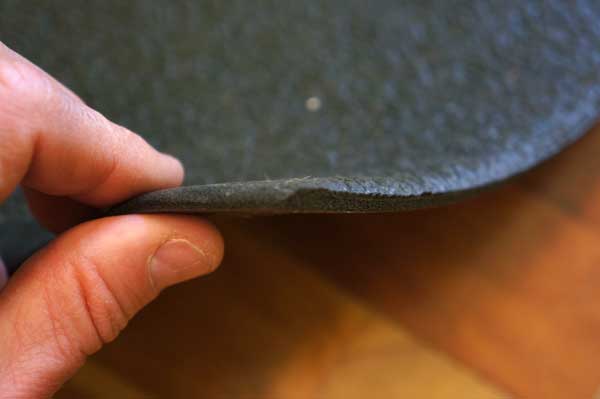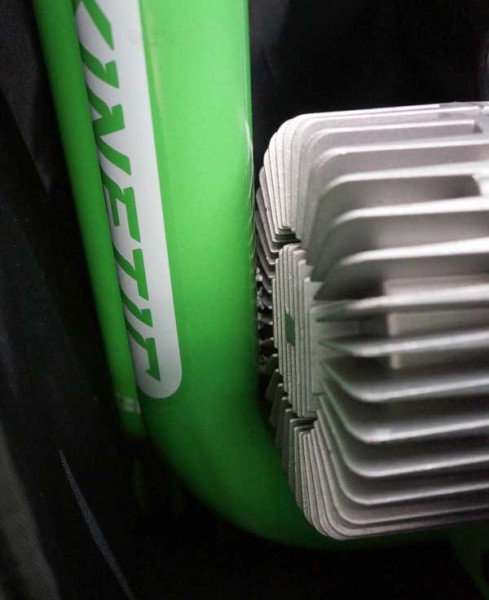In the age of connected “smart” trainers that relay your data directly to a computer (and soon directly into the cloud), a standard fluid trainer doesn’t seem nearly as exciting. But that doesn’t mean it can’t be darn good, and there are ways of making it talk to your devices, after all.
The Kurt Kinetic Road Machine is their top level static trainer. The Rock and Roll, which sways with your movement, is still their top model, but it’s $200 more and it doesn’t pack down easily for travel. Their line was overhauled in 2013 to improve compatibility with larger (mountain bike) tires, improve fit and finish of the knobs, and pack them completely assembled so you can jump right on as soon as you open the box. The resistance unit was unchanged, though, which is fine because it’s stellar.
Looking for a high end fluid trainer that keeps it simple? Spin on in and check out the details…
The Road Machine ($379) comes with slotted standard skewer cradles and standard skewer and a promo code for a free month of TrainerRoad.
All manner of accessories are available separately. We tested the front wheel Riser Ring ($29), trainer-specific tire ($60), padded carrying case w/shoulder strap ($65) and their Trainer Mat ($69). The bag zips shut and has a front exterior pocket panel to hold all the little stuff separately and makes for very convenient transport even if the trainer itself is pretty heavy. They make the Traxle thru axle adapter ($49), which we did not test but should work with any standard trainer and most bikes thanks to three different thread pitch options.
The imprints left on the mat measure 30.25″ (77cm) for the feet, and the rear end’s base is a bit more than 11″ (28cm). That creates a bedrock level of stiffness that kept it motionless whether I was trying to hit a 130 cadence or standing and draining every last drop of ATP from my legs sprinting for the virtual city limits. A narrower base can make it so the trainer rocks a bit under extreme efforts, particularly for taller riders whose centers of gravity are higher, but not this one. It’s rock solid.
Keeping the bike stable in such a good platform are the knobs, which thread on tight thanks to big, comfy knobs. The left side uses a locking nut to maintain its position. Set that one first, then slide the driveside knob inward until it makes full but loose contact. Then, flip the black lever to catch the threads and tighten as necessary. That little lever lock system makes it much quicker and easier to get the bike into place compared to systems that have to thread all the way in and out.
A similar knob is used to push the roller into the tire. The oversized roller makes solid contact with the tire without needing a ton of pressure. I could get my tires to slip a bit on the first explosive jump, but that’s happened on every traditional trainer I’ve tried. The fluid resistance unit is church mouse quiet. I didn’t notice any resistance loss from heat, likely thanks to the 80 huge fins.
Resistance is more than adequate. Besides being quieter, the benefit of a fluid trainer is that the resistance scales up as you pedal harder. Depending on the design, the rate of resistance progression can vary, and this one seemed just right. Its ramp seemed to mimic real world riding closely (they say it’s matched perfectly) and would get hard enough to simulate cranking up a hill when using a big gear combo. The unit is completely sealed, coupled to the roller magnetically, so it shouldn’t ever leak.
The flip side is the spin down. The Road Machine comes stock with a 6.25lb (2.83kg) flywheel, which did a decent job of maintaining momentum when coasting and providing a bit of spool-up resistance. They also sent their heavier Pro flywheel that attaches to the existing model to add about 12lbs, putting the total rotating mass at 18lb (8.16kg). We’ll review that separately.
If you’ve got an extra wheel and cassette laying around, it’s highly advisable to use the trainer tire or any old tire you’ve got laying around. Not only does it grip pretty well on the roller, but it’ll save your more expensive tires. After just two sessions, my Michelin Pro4 was showing undue signs of wear in the center.
The trainer is the cake, and their accessories are the icing that make it extra delicious. The Riser Ring has four different wheel height settings and is far more elegant than the phone book we’d been using. It’s also the only reasonably priced accessory…the others are a bit pricy.
The mat is thick, soft and awesome. It’s held up to quite a bit of foot traffic (and sweat) in our office, which would make it worth the price. But if your torture chamber sees less wear and tear, a much cheaper yoga mat would probably suffice. A towel works, too, as long as the trainer isn’t sitting on it, which could let it slide around under hard efforts…but a mat fits under the complete trainer and wheel block, which prevents any scratches on your floor.
The bag is nice, too, and fits the wheel block, tire and other bits neatly for travel or storage. The one downside is that when folded up and laid flat, the resistance unit could make contact with the frame and scratch it. And, because the resistance unit and flywheel are heavy and don’t sit centered in the frame when folded, it tends to want to fall over. Leaning it against something with the flywheel facing toward the wall is the solution.
Overall, the trainer is great, and it’s a fraction of the cost of a connected trainer and doesn’t require a wall plug to get all the features. The price is on high end of competing fluid trainers, but it comes with a larger stock flywheel than most, seemed a bit quieter than others I’ve tested and a good brand history to back it up. It has a road-like feel and has held up to multiple users over the past 8 months with nary a scratch on it. I’d recommend it to anyone looking for a premium unit that’s quiet, stable and durable.
For those looking to eek out a few data points, there are options. Kinetic makes a $170 Bluetooth-equipped InRide Watt Meter that combines a roller speed sensor and heart rate monitor to determine your power output, then display it all on your iOS device. Or, you can use any Bluetooth or ANT+ speed/cadence sensor to send the data to services like TrainerRoad, Zwift and others, which can use the data to predict power output, let you race virtually and myriad other things. As shown in our TrainerRoad review, it’s not hard to figure out.
